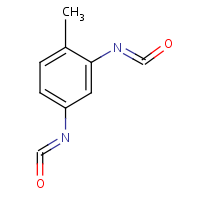Diisocyanatomethylbenzene
Agent Name
Diisocyanatomethylbenzene
CAS Number
1321-38-6
Formula
C9-H6-N2-O2
Major Category
Plastics & Rubber

Synonyms
Isocyanic acid, methylphenylene ester; Benzene, diisocyanatomethyl-; [ChemIDplus] Crudell TDI; 2,4-TDI unspecified isomer; [INCHEM PIMs] UN2078
Category
Diisocyanates
Description
Melting point = 20 deg C; [ChemIDplus] Colorless to yellow liquid or solid with a sweet, pungent, fruity odor; mp = 19.5-21.5 deg C; [INCHEM PIMs]
Sources/Uses
This is the crude form of toluene 2,4-diisocyanate (2,4-TDI) with an unspecified isomer ratio commercially available but not usually used; [INCHEM PIMs] Used to make polyurethane foams and coatings, elastomeric coating systems, adhesives, and sealants; Occupational exposure occurs in adhesives production, insulation application, resin and lacquer production, chemical synthesis, paint spraying, polyurethane foam production, work with rubber, shipbuilding, textile processing, and wire coating; [INCHEM PIMs]
Comments
Reacts with water; Inhalation is the most dangerous route of exposure; May cause skin sensitization; Reports of eye irritation, corneal edema, and conjunctivitis; Inhalation may cause systemic effects and hypersensitivity reactions; Animal studies have demonstrated that dermal exposure can cause pulmonary sensitization; Inhalation of concentrations above 3.5 mg/m3 may cause chemical pneumonitis; [INCHEM PIMs] See "Toluene 2,4-diisocyanate."
Biomedical References
Exposure Assessment
Vapor Pressure
0.0135 mm Hg
Explanatory Notes
VP from ChemIDplus;
Adverse Effects
Skin Sensitizer
Yes
Asthma
Yes
Toxic Pneumonitis
Yes
Fibrogenic
Yes
Diseases, Processes, and Activities Linked to This Agent
Diseases
Occupational diseases associated with exposure to this agent:
Processes
Industrial Processes with risk of exposure: